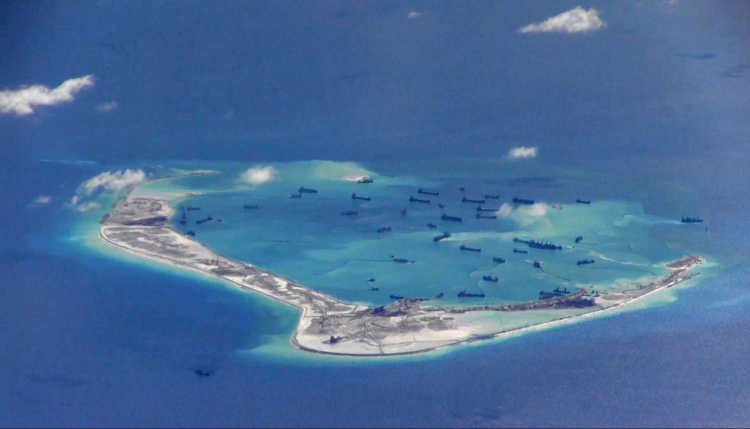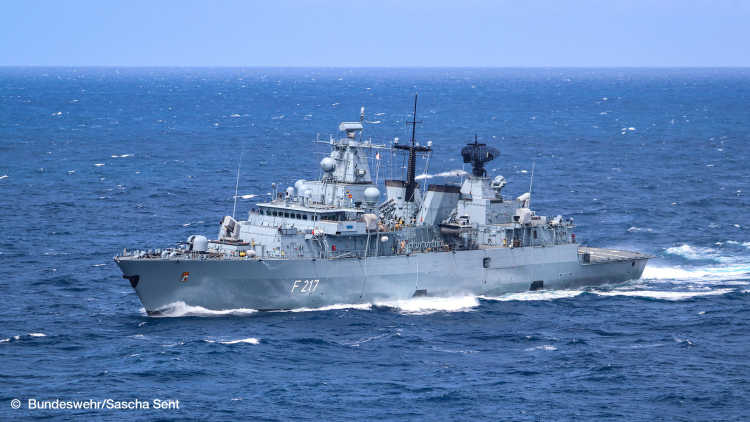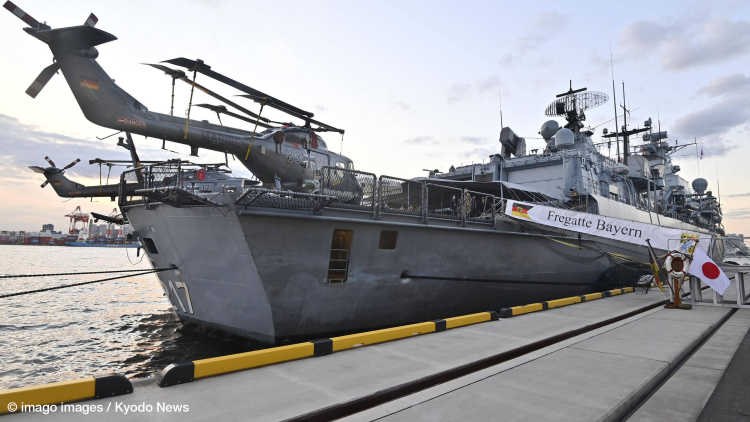- Home
- Publications
- GIGA Focus
- South China Sea "Lawfare": Fighting over the Freedom of Navigation
GIGA Focus Asia
South China Sea "Lawfare": Fighting over the Freedom of Navigation
Number 5 | 2020 | ISSN: 1862-359X

China’s expanding military presence and assertive conduct provoked strong concerns among Western nations about the freedom of navigation in the South China Sea. United States-led naval operations in contested areas have emerged as the preferred countermeasure thereto. However, diverging legal positions, complex territorial and maritime disputes, and growing aspirations to enlarged national spheres of influence have resulted in unintended outcomes. Recently, a flurry of diplomatic statements and several large-scale naval exercises have further elevated tensions.
A series of controversies over oceanographic surveying and military-surveillance activities in the South China Sea have brought to the fore the long-standing struggle between coastal states and naval powers as it shaped the United Nations Convention on the Law of the Sea (UNCLOS).
The US and China hold diametrically opposed views on the rights and freedoms of warships to navigate through territorial seas and operate in exclusive economic zones (EEZs). While China has been instrumentalising UNCLOS provisions and claims to historic rights as a security-political shield, the US has been striving to safeguard its armed forces’ freedom to manoeuver in East Asian seas.
China’s attempt to control almost the entire South China Sea and US-led efforts to push back against the former’s generally rising global influence have politicised the US Navy’s Freedom of Navigation Operations and obscured their objectives. Never designed to counter territorial claims, these have come to represent “shows of force.”
To put a halt to the accelerating militarisation of the South China Sea, the US and China need to overcome geopolitical tunnel visions regarding one another. Also, all coastal states have to recast their claims in conformity with UNCLOS and seek cooperative arrangements as the basis for future settlements.
Policy Implications
European diplomats and defence officials should encourage Southeast Asian governments to reduce, delimit, and regulate their overlapping territorial sovereignty, EEZ, and continental shelf claims. Unlike extra-regional powers’ blunt shows of force, such an alignment would put pressure on China and further the rule of international law. Europe should also encourage the US to ratify UNCLOS so as to increase the credibility of its position.
The Militarisation of the South China Sea
The militarisation of the South China Sea, an area covering 3.5 million square kilometres and one significantly larger than the Mediterranean Sea, is usually linked to China’s fortification of several geographical features of the Spratly Islands group. In 2014, the Chinese leadership ordered rapid and simultaneous large-scale land reclamations in order to replace makeshift outposts with infrastructure that can house battalion-sized military units. Facilitated by three newly built 3,000-metre-long runways and several large-scale berths, Chinese authorities also installed surveillance and weapons systems. These developments were paralleled by an increasingly assertive Chinese attitude towards the navigation of foreign warships and resource exploitation there. In 2016, the decision returned in a Philippines-initiated arbitration case threw this expansion into stark relief and led to the view that China had been challenging the freedom of navigation and working to undermine the United Nations Convention on the Law of the Sea (UNCLOS).
Policymakers and strategists in Washington are particularly concerned about Chinese efforts to deter United States aircraft carrier strike groups from operating in the East and South China Seas. To counter what became known as China’s “Anti-Access Area Denial” strategy for controlling the waters west of the Japanese Ryukyu Islands and the Philippine archipelago, they designed the “Air-Sea Battle” doctrine. Introduced in 2009, it was later renamed the “Joint Concept for Access and Maneuver in the Global Commons.” This geopolitical contest had made oceanographic surveying and military surveillance crucially important long before China’s recent foray into the Spratlys. Against this background, the heating up of territorial disputes in East Asian seas from 2009 onwards has exacerbated anxieties and cast a spotlight on the decades-old US Freedom of Navigation programme.
Facing increasing pressure to show resolve, the Barack Obama administration ordered a series of calibrated naval operations. It also encouraged others to join in defending the freedom of navigation. Australian policymakers refrained from expressly challenging Chinese claims through Freedom of Navigation Operations (FONOPs) but continued long-standing surveillance activities out of a Malaysian airbase. Meanwhile, Japan stepped up its naval diplomacy, including by deploying aircraft carriers so as to “send signals” to China. The British and French defence ministers, too, pledged to defend the rules-based order by way of exercising the naval freedom of navigation in the South China Sea. At the 2016 Shangri-La Dialogue both announced the dispatch of carrier-groups and other warships. Moreover, Japan and India have moved to fortify the Ryukyu island chain in the Western Pacific and the Andaman/Nicobar island chain in the Bay of Bengal respectively, as they straddle major shipping routes.
This development raises the questions of whether and if so how FONOPs do indeed safeguard navigational rights and freedoms and strengthen adherence to international law. To answer these, we first describe the legal and political contexts. Second, we outline the debate about the effectiveness of FONOPs. Third, we advance, from a European perspective, policy proposals for strengthening the rule of law over the rule of force.
Debating Navigational Rights and Freedoms
The controversy about navigational rights and freedoms revolves around two main issues: freedoms of navigation and overflight in exclusive economic zones (EEZs), and foreign warships’ rights to navigate through territorial seas and archipelagic waters. Upon concluding decades-long negotiations in 1982, UNCLOS codified navigational regimes to safeguard international navigation. Most importantly, all states enjoy freedom of navigation on the high seas and in coastal states’ 200 nautical-mile-wide EEZs. The EEZ was created as a new form of maritime zone so as to reconcile coastal states’ insistence on exclusive economic rights and naval powers’ insistence on high seas freedoms of navigation. Thus, the EEZ is not a maritime zone of sovereignty but one of functionally limited rights and jurisdiction; coastal states have to accept the exercise of various high seas freedoms.
In the territorial sea of up to 12 nautical miles (NM) from their shores and in the internal waters located landwards of the baselines, on the other hand, coastal states have sovereignty, limited only in the territorial sea by the relatively restrictive right of “innocent passage.” This right allows ships to sail through another state’s territorial sea in a “continuous and expeditious” manner that is not “prejudicial to the peace, good order or security of the coastal state”. It precludes various activities such as, for example, operating ship-borne aircraft, research, and surveillance, and also requires submarines to surface and show their flag. Innocent passage can be suspended under certain strict conditions, and no associated right of overflight exists. Some coastal states insist on prior notification or authorisation for the passage of foreign warships, but the legality of such practices is doubtful.
Strips of territorial sea that form part of straits used for international navigation and are located between high seas or EEZs, fall within the more liberal “transit passage” regime. This regime was first established by UNCLOS following pressure by great powers with ocean-going navies and allows ships – including warships – to navigate continuously and expeditiously in their “normal modes of operation.” For example, submarines may remain submerged. Unlike innocent passage, the right of transit passage cannot be suspended and includes the right of overflight.
Further, following successful lobbying by island nations such as Indonesia and the Philippines, a new regime of archipelagic states and archipelagic waters would be included in UNCLOS. Archipelagic states may draw archipelagic baselines between their islands, the waters landwards of which constitute archipelagic waters. These archipelagic waters, like the territorial sea, fall within archipelagic states’ sovereignty. In these waters, foreign ships enjoy innocent passage as well as “archipelagic sea lanes passage” – which essentially amounts to a somewhat more limited form of transit passage (“continuous, expeditious and unobstructed transit”). An important difference is that archipelagic states may designate archipelagic sea lanes for this purpose.
Yet, the practical implementation of these navigational regimes raises many difficult questions. While the US is a proponent of liberal interpretations, China takes very restrictive positions regarding the navigational rights of foreign warships. Most developed Western states have traditionally aligned themselves with the US interpretation, while many Asian developing countries – including e.g. India – hold views that are closer to China’s (Kaye 2008). Although China has by now built up the world’s second most powerful naval force, its stance remains reminiscent of an insecure developing country. Like many other coastal states, China strives to use international law – including UNCLOS – to expand its maritime rights and jurisdiction, and to establish control over adjacent maritime spaces and resources. Unlike other powers with ocean-going navies and similar to other developing coastal states, however, it also seeks to restrict the movement of foreign warships by stretching legal interpretations beyond UNCLOS provisions.
China not only generously draws straight baselines in order to enlarge its territorial seas and extend its other maritime zones farther into the high seas; it also adopts expansive interpretations of the “island” concept, arguing that these may serve as the basis for EEZ claims. In its territorial seas, China insists that foreign warships obtain prior authorisation before exercising their right of innocent passage. China also maintains that surveillance and oceanographic surveying, crucial for the operations of naval forces, require prior authorisation in its EEZs. Attempts to enforce this view have seriously damaged relations with the US. A Chinese fighter jet’s mid-air collision with a US EP-3 type surveillance plane in April 2001 and Chinese government vessels, trawlers, and airplanes obstructing operations of the oceanographic survey vessel USNS Impeccable in March 2009 are well-known examples hereof. Recurring confrontations of this kind have been the decisive factor in shaping antagonistic security policies and cannot be underestimated.
The fact that China, together with Taiwan, claims most of the South China Sea only exacerbates this problem. To be sure, Chinese authorities have never clarified their claims in the legal terms of UNCLOS. Over the last decade, however, the debate about the meaning of the so-called nine-dash line that encompasses almost the entire South China Sea has ultimately evolved to the position that everything within belongs to China (Gao and Jia 2013). Chinese leaders have long been anxious about foreign intervention in a Taiwan Strait contingency and the possibility that the powerful US Navy and its allies could strangle the Chinese economy by disrupting energy and trade flows through Southeast Asian seas – especially the “choke point” of the Malacca Straits. Hence, China’s control over the South China Sea has been treated as a non-negotiable “core interest” since 2011.
This portrayal mirrors former Secretary of State Hillary Clinton’s declaration at the July 2010 Association of Southeast Asian Nations (ASEAN) Regional Forum meeting that the freedom of navigation in the South China Sea constituted a US “national interest.” For US policymakers, coastal states’ drive to expand territorial control coupled with the generally advancing regulation of the seas for economic, environmental, and other purposes, known as “creeping jurisdiction,” has been a long-standing concern (Wilson and Kraska 2009). They fear that pertaining UNCLOS norms will impose restrictions on US naval vessels and aircraft operating in the “global commons.”
In essence, China and the US hold opposing views on the very nature of the EEZ as an extension of sovereign rights from the land into the sea, or as an extension of high seas freedoms toward the coast, respectively (Bateman 2020). Accordingly, the US argument that oceanographic surveillance and military surveying are permissible in EEZs as long as the obtained data serves military purposes only strikes the wrong chord in Beijing. Yet, the US is in an awkward position in relying on UNCLOS regardless. It has not yet ratified the Convention, and instead claims that most of its provisions reflect customary international law.
Debating Freedom of Navigation Operations
To counter creeping jurisdiction, the US in 1979 initiated the Freedom of Navigation Program. It consists of bilateral and multilateral consultations, diplomatic representations, and operational assertions by government vessels and aircraft directed at perceived excessive claims by individual coastal states – allies and rivals alike. Since 2009 drastically rising tensions over the South China Sea, however, have altered the overall context and stirred debates about the FONOPs’ legal effectiveness, political nature, and relationship to broader geopolitical objectives.
Under President Obama, the US labelled one naval operation in 2013, two in 2015, and three in 2016 as South China Sea FONOPs. Under President Donald Trump, meanwhile, the US Navy conducted six FONOPs there in 2017, five in 2018, seven in 2019, and five in 2020 as of the time of writing in August of that year. In addition, surveillance aircraft and long-range bombers have been asserting the freedom of overflight.
Officially, FONOPs serve a legal purpose. However, given the above-mentioned developments, naval assertions invariably became tools in regional politics and for global geopolitical strategizing. By their very nature, the narrow, technically sophisticated, and inherently competing legal arguments of the involved states have been appropriated for parochial political purposes and assimilated into grand geopolitical narratives. For a number of reasons, it has not always been clear what coastal state practices exactly FONOPs in the South China Sea are even meant to protest. First, China – similar to other coastal states – has intentionally remained ambiguous about its claims, making it difficult to identify clear targets vis-à-vis legal assertions. Second, the arbitrators in the 2016 Philippines versus China case found that none of the South China Sea’s disputed geographic features can generate EEZs and that many are low-tide elevations that are not even entitled to a territorial sea. Third, neither politics nor law is governed by objective truths. Perceptions matter. Therefore, the outcomes of FONOPs often diverge considerably from intended effects. Ostensibly designed to further the rule of law over the rule of force, they appear as mere tools of “lawfare” – a term coined to capture the instrumentalization of law for furthering parochial political interests, including military objectives.
Apart from the fundamental differences between China and the US over permissible oceanographic surveying and military surveillance in EEZs, several operational assertions have been legally unsound. For instance, the reported passage of the destroyer USS Lassen “within 12 NM” of Subi Reef in October 2015 could be seen as unintentionally reinforcing China’s dubious potential claim to a territorial sea around this low-tide elevation (LaGrone 2015). A further example of unclear messaging is the USS Dewey’s operation “within 12 NM” of Mischief Reef, another low-tide elevation that cannot create a 12 NM territorial sea of its own (Dutton and Kardon 2017).
A lack of transparency complicates FONOPs’ effectiveness in countering China’s excessive claims legally and politically, too. As a general rule, US authorities, like their British and French counterparts, provide no legal and operational details. Yet, partial information such as the name of the ship involved and the geographical feature in question deliberately transpires through the US media or official Chinese protests. Only in cases where the Chinese air force, navy, coastguard, or fishermen militia stage aggressive resistance will details be disclosed. Thus, what emerges in the public domain is not arguments that could coalesce into a legal consensus but rather recurring episodes of only confrontational rhetoric and provocative behaviour. Seemingly, both US and Chinese decision-makers find it difficult to overcome political and legal situations that they perceive as undesirable without inadvertently emphasising them.
The problem of distinguishing protest against creeping jurisdiction from objections to expansive territorial claims further politicises FONOPs. Successive US administrations have made clear that they remain neutral in sovereignty disputes and merely insist on non-coercive settlements. However, China’s maritime claims in the South China Sea mostly rely on the premise of territorial sovereignty over claimed features as well as the legal status of the latter. Thus, politics trumps law because China’s expansive territorial claims inevitably make the country the principal target of FONOPs. Additionally, China’s many rivals such as the US, Japan, and India use the freedom of navigation argument to rally international support against the Middle Kingdom’s attempts to restore imperial reach. Not least, UNCLOS and the South China Sea quagmire are too complex to be explained in news cycles. The further militarisation of the maritime sphere is the consequence. Therefore, experts at the US Naval War College recommend the separation of the global FONOPs programme against creeping jurisdiction from concerns over the freedom of navigation in the South China Sea – and so simply “just fly, sail and operate wherever international law allows” (Dutton and Kardon 2017).
Towards Greater Sophistication or Escalation?
For this policy change to happen, two specific issues need to be addressed. First, China’s aggressive assertion of vast territorial and maritime claims demands more sophisticated responses if the US wants to remain credible in the eyes of its East Asian allies and partners. As much as they satisfy impulses to “do something,” FONOPs and other “shows of force” remain ineffective in genuinely countering China’s subtle “salami-slicing” or “grey zone” tactics. On the contrary, shows of force fuel tensions. Aside from making Chinese leaders ever more determined to defend their core interests at all costs, they also heighten general insecurity and increase East Asian allies’ demands for US reassurances even further (Cooper and Poling 2019).
Second, the framing of the freedom of navigation for (US) warships as a geopolitical problem inevitably caused by China’s rise upends ostensible efforts to strengthen the rule of law over the rule of force. This geopolitical lens mandates the intensification of balancing through military means. It not only elevates the use of military force to the only effective course of action, but also reduces the issue to one of Sino–US superpower competition. Both the US and Chinese poles get strengthened militarily. While the Communist Party of China has long viewed every aspect of political and social life through the lens of regime security, the US government – especially under the Trump administration – has come to see the actions taken by China and Chinese individuals as potential threats. Very few issues remain outside the purview of national security politics.
This trend could be reversed if the US tailored its response to China’s territorial and maritime expansion to the disputes’ specifics, and only moved in lockstep with the concerned East Asian partners as long as these adhere to UNCLOS. A series of diplomatic statements may indicate such a policy change being underway. In a June 2020 note verbale to the United Nations and a July 2020 statement by Secretary of State Mike Pompeo, the US reiterated and clarified somewhat its position on the legal nature of specific geological features. Thus, despite formally remaining neutral on territorial disputes the US in fact appears to side with the arbitrators in the aforementioned Philippines versus China case. In light of the Trump administration’s “whole of government” approach to curtailing China’s perceived global influence as well as of the enhanced US naval presence in contested areas of the South China Sea, this might just be an escalatory act of lawfare. Yet, related diplomatic interventions by Australia, China, Indonesia, Malaysia, the Philippines, Taiwan and Vietnam could also promote solutions based on the law of the sea.
In any case for this strategy to successfully de-escalate the situation and further the rule of law it will first be necessary to sort out the disputes’ intra-Southeast Asian dimensions. This can work if the concern about the freedom of navigation is separated from that of disputes about territorial sovereignty and maritime delimitation, and if both issues are separated from broader geopolitical objectives. Thus, the law of the sea as applied in the Philippines versus China arbitration can be useful for overcoming the quagmire by, first, aligning Southeast Asian governments’ positions and by, second, giving China the choice to either join in or face a united opposition.
Europe’s Role in Strengthening the Rule of the Law of the Sea
Interestingly, those Southeast Asian states who would be most affected by the interruption of maritime transport are more concerned with issues of sovereignty and marine resources than with ones of sea-lane security and navigational rights and freedoms. External powers such as Australia and the US, in contrast, exaggerate their economic dependencies on trade via the South China Sea – much of which is to and from China – and conflate it with the freedom of navigation for their warships (RSIS 2017). This situation points to the underlying geopolitics driving the ongoing lawfare. Thus, the solution for demilitarising the South China Sea lies in the coastal states of Southeast Asia, who harbour no geopolitical ambitions of their own, to take the lead. It is in their interests to defer to UNCLOS for preserving diplomatic and security-political space in the face of intensifying great power rivalry. An ASEAN leaders’ statement of June 2020 testifies to this, in that it reaffirmed the importance of “upholding international law, including the 1982 UNCLOS, in the South China Sea” while also stressing the significance of “non-militarisation and self-restraint in the conduct of activities that would complicate or escalate disputes and affect peace and stability” (ASEAN 2020: 4).
This insight leads to three policy recommendations. First, conscious of the complex political relations within East Asia and between China on the one hand and the US and its allies on the other, European policymakers should resist the temptation to stage naval shows of force. These are not only mere shows, but furthermore create the impression – also in Southeast Asian eyes – that Europeans think of themselves as being on the side of the law simply because of being European and militarily powerful. While such shows may cover for policymakers’ lack of better ideas, extra-regional actors’ uninvited FONOPs inevitably raise the question of hidden geopolitical motives. Unlike Australia, which mostly continues long-standing practice, a new emphasis on a European military presence in the South China Sea that goes beyond standard naval diplomacy almost certainly contributes to the escalatory spiral. If Europe was to insert itself in the Sino–US geopolitical contest for primacy there, it would neither end Chinese assertiveness nor see East Asia or the Indo-Pacific become more stable. Therefore, European participation in exercises at sea should be limited to cases where Southeast Asian states – who pursue defensive policies – take the lead.
Second, European policymakers should encourage primarily Vietnam, the Philippines, and Malaysia to formulate their maritime claims in conformity with UNCLOS. This requires unilateral action such as the modification and clarification of existing claims and the establishment of coherent national policies and regulations – steps that experts in the Philippines and Vietnam have begun to ponder (McDorman 2017). These steps need to be complemented with bilateral and minilateral agreements (Laksmana and Waffaa 2020), including delimitation and sectoral cooperation arrangements. The outcomes of the 2016 Philippines–China arbitration case – especially the denial of China’s historic rights argument, the narrow definition of most disputed features as low-tide elevations or rocks, and the emphasis on coastal states’ responsibilities to protect the marine environment – can provide a helpful frame of reference to this end. The ASEAN leaders’ statement of June 2020 is a first rhetorical step in this direction. In addition, in July 2020 the government of President Rodrigo Duterte of the Philippines seemed to abandon its previous conciliatory attitude and expressly asked China to comply with the 2016 decision of the arbitral tribunal. Given past experiences with formal dispute-settlement mechanisms, Southeast Asian states could also consider the initiation of further arbitration proceedings under UNCLOS. In any case, future agreements and arrangements must leave openings for China and Taiwan to join in or participate. At the same time European policymakers must bear in mind that parts of the arbitral award – including its very broad interpretation of the tribunal’s jurisdiction and its unexpectedly narrow conception of “islands” that possess an EEZ or continental shelf of their own – remain controversial among experts and governments around the world. Also, European leaders and experts should confront the US Senate with the fact that its continued refusal to ratify UNCLOS weakens the US’s position – and, indeed, the treaty as a whole.
Third and finally, European policymakers should encourage the US and China to continue serious negotiations over military activities off their respective shores. These need to go beyond the mere exchange of EEZ-related legal interpretations and focus on major political questions. Unless the two find a political compromise, tensions will continue to rise and spread. Once the Chinese Navy starts to push back against US activities in the northern part of the South China Sea and extends its surveillance operations (like those it sometimes conducts around Japan) to include areas off US and allied naval bases, it will not only reveal its double standards on the legality of military-related surveying and surveillance in EEZ. Although the US government has in the past accepted these activities as lawful, political commentators’ reactions to Chinese vessels observing allied exercises off Alaska, Australia, and Hawaii suggest that such a policy change will also trigger even stronger responses in the US, in allied capitals, and beyond, thereby furthering the militarisation of the seas.
Europe would serve itself, the East Asian region, and the wider international community best if it provided an alternative to advancing polarisation and militarisation. A clear focus on international law, rather than on lawfare, will not only help to align Southeast Asian positions, but also preclude tensions between European Union member states whose national interests in the Indo-Pacific may not be one and the same.
Footnotes
References
ASEAN (Association of Southeast Asian Nations) (2020), ASEAN Leaders’ Vision Statement on a Cohesive and Responsive ASEAN: Rising above Challenges and Sustaining Growth, 26 June.
Bateman, Sam (2020), Freedoms of Navigation in the Asia-Pacific Region: Strategic, Political and Legal Factors, New York: Routledge.
Cooper, Zack, and Gregory Poling (2019), America’s Freedom of Navigation Operations Are Lost at Sea, in: Foreign Policy, 8 January
Dutton, Peter A., and Isaac B. Kardon (2017), Forget the FONOPs – Just Fly, Sail and Operate Wherever International Law Allows, in: Lawfare Blog, 10 June.
Gao, Zhiguo, and Bing Bing Jia (2013), The Nine-dash Line in the South China Sea; History, Status, and Implications, in: American Journal of International Law, 107, 1, 98–123.
Kaye, Stuart (2008), Freedom of Navigation in the Indo-Pacific Region, Sea Power Centre – Australia Papers in Australian Maritime Affairs 22, Canberra: Commonwealth of Australia.
LaGrone, Sam (2015), U.S. Destroyer Made an ‘Innocent Passage’ Near Chinese South China Sea Artificial Island in Recent Mission, in: USNI News, 2 November.
Laksmana, Evan, and Kharisma Waffaa (2020), Safeguarding the Shared Maritime Domain between Indonesia, Vietnam, and Malaysia, CSIS Event Report, Jakarta: CSIS Indonesia.
McDorman, Ted L. (2017), An International Law Perspective on Insular Features (Islands) and Low-tide Elevations in the South China Sea, in: The International Journal of Marine and Coastal Law, 32, 2, 298–315.
RSIS (Rajaratnam School of International Studies) (2017), Understanding Freedoms of Navigation – ASEAN Perspectives, Event Report, 7 March, www.rsis.edu.sg/wp-content/uploads/2017/08/ER170808_Freedom-of-Navigation_WEB.pdf (10 August 2020).
Wilson, Brian, and James Kraska (2009), American Security and Law of the Sea, in: Ocean Development & International Law, 40, 3, 268–290.
General Editor GIGA Focus
Editor GIGA Focus Asia
Editorial Department GIGA Focus Asia
Regional Institutes
Research Programmes
How to cite this article
Wirth, Christian, and Valentin Schatz (2020), South China Sea "Lawfare": Fighting over the Freedom of Navigation, GIGA Focus Asia, 5, Hamburg: German Institute for Global and Area Studies (GIGA), https://nbn-resolving.org/urn:nbn:de:0168-ssoar-69365-6
Imprint
The GIGA Focus is an Open Access publication and can be read on the Internet and downloaded free of charge at www.giga-hamburg.de/en/publications/giga-focus. According to the conditions of the Creative-Commons license Attribution-No Derivative Works 3.0, this publication may be freely duplicated, circulated, and made accessible to the public. The particular conditions include the correct indication of the initial publication as GIGA Focus and no changes in or abbreviation of texts.
The German Institute for Global and Area Studies (GIGA) – Leibniz-Institut für Globale und Regionale Studien in Hamburg publishes the Focus series on Africa, Asia, Latin America, the Middle East and global issues. The GIGA Focus is edited and published by the GIGA. The views and opinions expressed are solely those of the authors and do not necessarily reflect those of the institute. Authors alone are responsible for the content of their articles. GIGA and the authors cannot be held liable for any errors and omissions, or for any consequences arising from the use of the information provided.
























